I wasn’t sure what to expect from “What We Hold," but, as I told my friend in the lobby of the Irish Arts Center on Wednesday night, when I saw 'Jean Butler' and 'Irish dance,' I knew I needed tickets.
The Irish Arts Center was happy to oblige to my request for press passes - lucky for me, as most of the remaining performances are sold out, an early mark of success in Butler's latest endeavor that is in the midst of its US premiere after a well-received premiere in Dublin.
For context, I began Irish dance classes in New Jersey at the age of three. I was still a child when, in 1994, Irish Americans Jean Butler and Michael Flatley, both champion Irish dancers, starred as the leads in “Riverdance" when it premiered as the interval act at the Eurovision Song Contest.
Audiences were enamored by the modern, new look of Irish dance. "Riverdance" was quickly adapted into a full stage production; it toured the world, becoming a global phenomenon.
With "Riverdance," Irish dance - for better or for worse - suddenly became cool, glitzy, and, dare I say, sexy.
The modern look espoused by "Riverdance" did not remain exclusive to stage productions; it informed the trends in the competitive world of Irish dance - costumes became glitzier, and makeup became heavier.
After "Riverdance," Flatley continued on the showbiz route while Butler later turned to "working in a contemporary dance context" and exploring the more academic side of Irish dance.
In more recent years, Butler founded Our Steps, which, in her own words, "is dedicated to exploring ideas around Irish-ness and the dancing body, to provoking questions about our collective history and to initiating works that invite other dance forms and other arts forms to connect and collaborate with our culturally specific practice.”
The "What We Hold" show is born out of the commendable Our Steps non-profit organization, which is building an archive of Irish dance and has commissioned several essays.
"What We Hold" is unlike any other Irish dance show I've seen. Before entering the theater, the audience is told that the first two sections of the nearly hour-long show are a "promenade."
As the doors open to the dimly lit theater, the audience enters to the sounds of World Champion James Greenan rallying repetitive and rhythmic trebles on a small practice board in front of three large mirrors. There is no music, just his beats. The audience stands semi-circled around him during his ten-minute solo during which you're not sure if time has sped up or stopped completely.
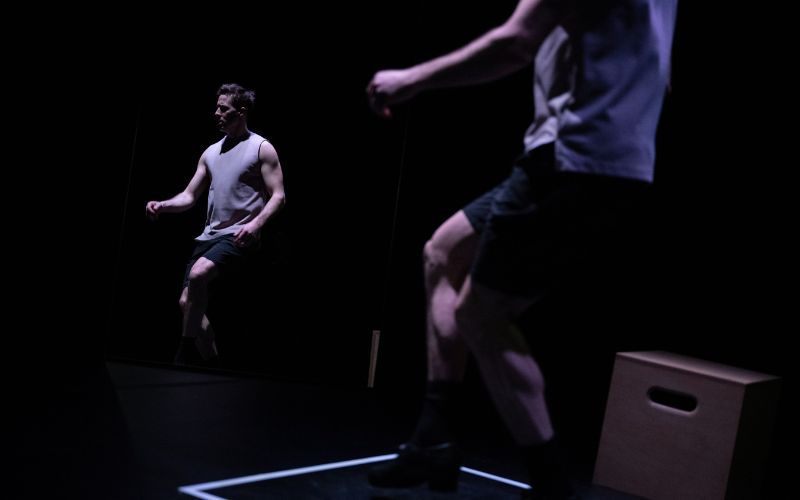
James Greenan in "What We Hold." (Nir Arieli.)
Towards the end of Greenan's solo, Butler emerges, unannounced, in the shadows at the back corner of the room, observing Greenan silently as part of the audience.
Greenan, understandably sweaty, concludes his masterful solo. The lights rise ever so slightly and the mirrors are moved out of the way. Butler crosses on the floor, gracefully gesturing for the audience to turn its attention to Colin Dunne, the former "Riverdance" principal dancer who is atop a box in the opposite corner.
Unlike Greenan, Dunne performs a solo that is mostly composed of swaying light steps to light music. Butler again watches on. Dunne seems pensive and nearly hesitant, a theme that will run throughout the remainder of the show.
As Dunne concludes, Butler again gestures for the audience to follow her, this time behind a black curtain that divides the front half of the stage from the back.
Behind the curtain is a more brightly lit banquet table, though it is simple, looking as if it's made of plywood. Chairs neatly line the long table that has two stern-faced Irish dancers - Kaitlyn Sardin and Maren Shanks - poised, waiting for the audience to take their seats.
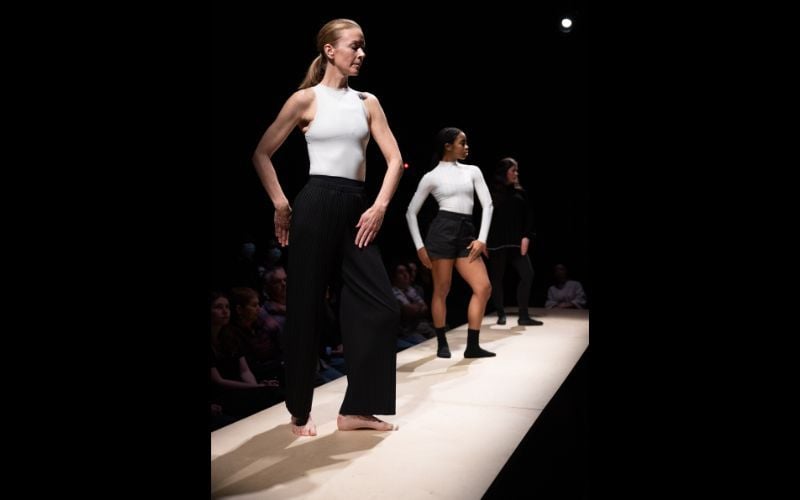
Jean Butler, Kaitlyn Sardin, Maren Shanks in "What We Hold." (Nir Arieli.)`
It is here I notice the costume choices. In their solos, Greenan wears shorts and a tank top, and Dunne wears slacks and a top.
On the banquet table, Shanks has on black tights and a long-sleeved, simple black dress, invoking the same style Butler would have worn on stage during her "Riverdance" days. Notably, Shanks is the only one of this trio wearing modern-style ghillies.
Sardin, meanwhile, has on black athletic shorts, a simple white top, and no shoes, only black socks. Butler, entirely barefoot, has on a simple, fitted white tank and flowy black pants.
There is minimal, if any, makeup and hair. The costumes are understated. There is no glitz.
I wonder if the costume choices are a direct rebuke to the flashiness that both competitive and performative Irish dance have come to be associated with. Can the opposing styles exist in harmony in today’s Irish dance world?
The question reminds me that Irish dance, which has humble beginnings, existed before competitions and big stage productions. While glitz helped launch Irish dance into the mainstream, Irish dance (hopefully) doesn't need it to continue to exist.
Shanks, Sardin, and Butler glide through what can only be described as a modern, interpretive Irish dance routine accompanied by music interweaved with the recordings from the “Our Steps” history collection. Voices old and young, Irish and otherwise, provide soundbites of their experiences in Irish dance.
This portion of the show concludes with Butler performing a solo, a blend of classic Irish dance and modern interpretation. Despite decades as a dancer, Butler remains as skillful and captivating as ever.
The audience is then invited again to return to the front part of the stage where seats have now been arranged in a semi-circle arrangement. Ryan Seaton, the show's composer and sound designer, is situated at the back behind his laptop in clear view.
Butler, Greenan, Dunne, Shanks, and Sardin are joined by former champion dancer Tom Cashin, contemporary dancer Marion Cronin, and performer Kristyn Fontanella for the final piece of the "What We Hold." At times, the choreography in this portion mimics structures of traditional ceili dances, but also breaks into new formations no doubt informed by Butler's keen understanding of the history of Irish dance and her studies in contemporary dance.
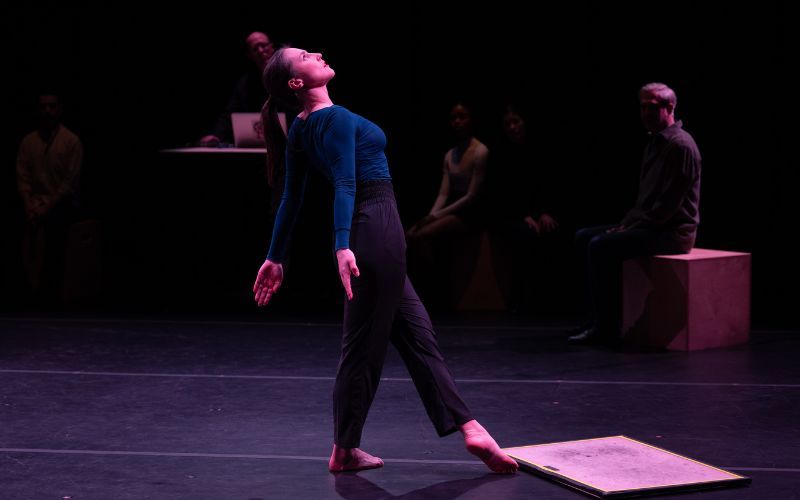
Marion Cronin in "What We Hold." (Nir Arieli.)
Irish dance traditionalists will savor Cashin's old-school style performance of the set dance "Kilkenny Races."
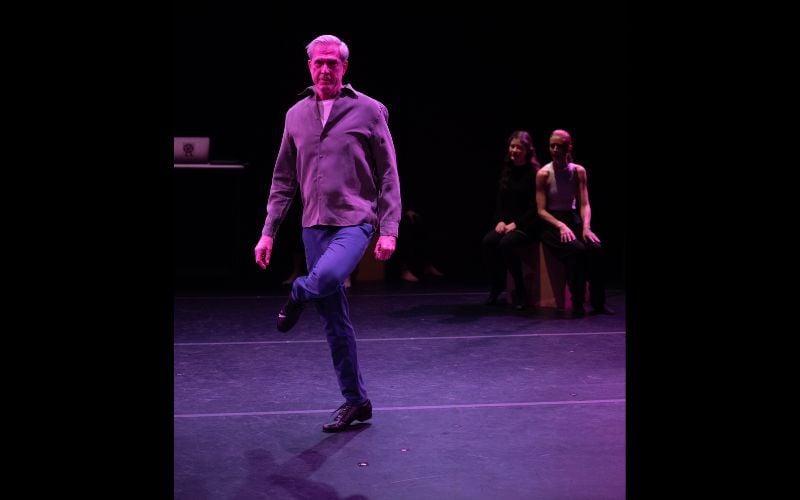
Tom Cashin, with Maren Shanks and Jean Butler in the background. (Nir Arieli.)
The show concludes on a high note with the group mesmerizingly moving as one before joyfully throwing their hands to the sky in a sort of modern, freestyle Irish dance. No surprise that the talented cast is treated to a standing ovation.
While I doubt that "What We Hold" will have the same widespread impact as "Riverdance," Butler can be proud of yet again ushering in a new understanding of what Irish dance can be.
*"What We Hold" runs at the Irish Arts Center through March 3, 2024. Ticket information here.
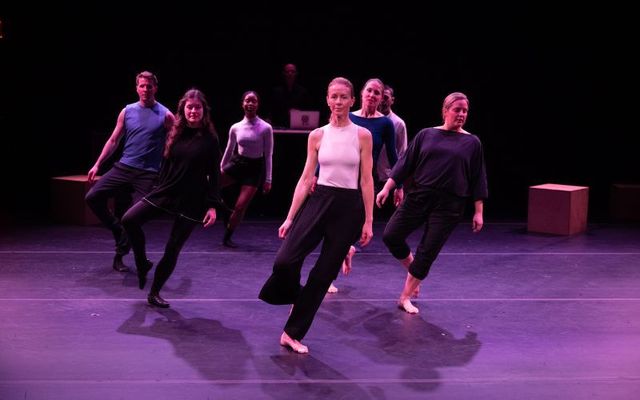



Comments